

Search the Journey to Forever website – click HERE

Navigation
|
About Handmade Projects
Spanish version -- Versión en español
Introduction
Project members
The team
Keith Addison and Midori Hiraga founded Handmade Projects NGO in Hong Kong in 1998 to organize the Journey to Forever project, moved into the old Beach House canteen in Pui O village on Lantau Island and made it the project headquarters.

The Beach House: where Journey to Forever was planned
|
The project was conceived in 1997 when Keith revisited Cape Town, his birthplace.
"I left South Africa 25 years ago, for political reasons," he says. "I worked for the black press there, until 1976, the year of the Soweto Uprising. It was led by schoolkids. All over the country black schoolkids went on strike and took to the streets in protest at the apartheid system.
"The response was vicious – the police shot at least 2,000 black schoolchildren that year. It wasn't really a surprise, I'd seen it coming, but it was a hell of a shock just the same. And it didn't leave any hope for peace -- you can't expect people to be reasonable after you shoot their children in the streets. So I left, and came here to Hong Kong. I've spent most of my time around here and in Europe since then.
"I more or less forgot about South Africa and got involved in Third World development work instead.
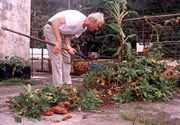
Keith harvesting sweet potatoes at the Beach House on Lantau Island
|
Actually there wasn't that much difference, black people in South Africa shared a great deal with Third World people: rural poverty, the victims of an unjust system.
"I went back a couple of times, briefly, for family reasons, but I wasn't at all pleased to be there and couldn't leave soon enough. But in the early 90s things started to change in South Africa. Nelson Mandela was freed, and a lot of my friends returned after that. I couldn't see it though – millions of lives ruined, a long and terrible heritage of brutality and oppression... It would take more than letting one man out of jail to fix that.
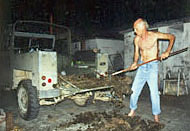
Unloading water buffalo manure from the Land Rover -- good compost material
|
"Yet, it made all the difference. The kind of power that grows from the barrel of a gun is useless against a man like Nelson Mandela. It was really the schoolkids who started it in 1976, but in the end the armed might of the apartheid regime was defeated by the sheer moral force of one man's spirit, and that's about the best thing of I've ever heard of, it makes everything seem possible.
"Anyway, in 1997 there was a bit of a family crisis once again, which I could have shrugged off, but I decided to go and see how I felt about the place these days. And I was glad I did: I got a very good feeling about it. Sure, it's still got every kind of problem, but they don't shoot children in the streets anymore. What we'd been working for and hoping for back in those old days was coming to pass: there was hope again, where there'd been none.
"So I decided to go back. I wasn't sure it was actually 'back', and it definitely wasn't back 'home' -- I long ago lost the concept of home, I don't even feel the need for such a thing now, nor any sense of loss either. But it felt like I should go there and see what would happen to me. I know feelings like that, they've been leading me around by the nose all my life, no sense in arguing, you just have to do it.
"Then I went back to Hong Kong. And found myself thinking, Yes, that's all very well, but what about my Land Rover? I really liked my Land Rover – it hadn't been running for more than a year and had been sidelined by silly bureaucratic problems and bits of paper and so on, but I wasn't prepared to abandon it. I'd had lots of adventures in Land Rovers but I'd never owned one before, it was a real thrill. Also it's kind of special – Land Rover Lightweights are not easy to come by.
"So I found out how much it was going to cost me to put it in a container to go by sea, and I'd go by air, but then I thought, No, that can't be right, it's supposed to take me, not me take it.

Keith driving the Land Rover Lightweight at Pui O beach (Dan Groshong)
|
"So that's how Journey to Forever came about – it's the Land Rover's crazy idea, not mine. It wants to go for a ride.
"It was never going to be just a journey, from A to B. I've done a lot of travelling journalism, I can easily earn a living that way. So that's what I'd do, a long – really long! – working trip, chasing stories all along the way, spending a lot of time off the beaten track, and the Land Rover would take me anywhere I wanted to go, perfect.
"And with a laptop and a satellite communications unit I'd be really independent, full Internet access from anywhere. This is what I'd always wanted to do.
"Then I started to realize that the Land Rover's capable of a lot more: they're built for rural work, you can run all kinds of machines and implements off them – powerful things to take into poor Third World villages. And my own capabilities – I'm a Third World journalist, but I haven't just written about Third World projects, I've done them.

Midori and a one-basket garden, for schools projects
|
"So the journey turned into a sort of moving development project. As well as researching and delivering stories, I could also use the Internet to access expert advice when we needed it. With all this in mind, the opportunities for education seemed obvious, so it became a schools project too.
"Good, now we had a proper project plan – 'we' since Midori had joined the project by then. But that's her story, not mine.
"Why 'Journey to Forever'? Well, look around: the way we humans are behaving these days you'd think you can buy new planets by the dozen in the local supermarket. The deserts are spreading, the forests are shrinking, the climate is changing, the water's drying up, whole species vanish for good by the minute, pollution is literally everywhere, there's even a hole in the sky, and never before have so many people been so poor and so few people been so rich.
"This is not what people want, but most people feel helpless to do anything about it. Some people now see humans as some kind of super-predator that's gotten right out of control, a sort of planetary cancer, and the sooner we destroy ourselves, well, the better for everything else.
"But it's just not true. In fact most people live pretty much in harmony with nature, as they've always done – all the traditional ways of life around the globe got that right a long time ago, or they'd never have survived this far. But it's getting difficult to follow the old ways – impossible, for many.
"Why? Overpopulation? It's a myth, a symptom of what's wrong, not the cause of it. Nearly a billion go hungry – in a world where never before has there been so much food per capita: 4.3 lbs of food per day for each human alive, more than enough for everyone.
"Hundreds of millions are landless – while in some of the hungriest and most 'overpopulated' countries most of the land is owned by tiny elites who use only a fraction of their holdings while the rest lies idle.
"And the rate of poverty is growing faster than the population is.
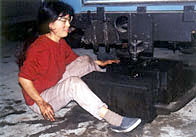
Midori fixing a leaking tank on her Land Rover 109 -- what a struggle!
|
"What confronts us is not some intractable result of Malthusian biology, enough to make anyone feel helpless – it's simply injustice. Injustice can be stopped in its tracks. And you don't have to be Nelson Mandela to do it – everyone has something valuable to contribute.
"Change is in the air, the tools are at hand. We hope Journey to Forever will give people – anyone with a computer, and especially schoolkids – the chance to prove for themselves that they can make a difference.
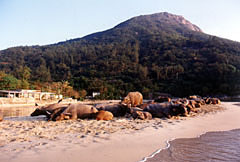
The Beach House and the neighbours
|
"It's called Journey to Forever because mankind does have a future and there is a way forward, or many ways forward. The traditional societies have sustainable systems that lasted for thousands of years, and we have to learn from them, as it says very clearly in Agenda 21, the Earth Summit declaration of 1992.
"But we can do better than that. Another of the extremes of our times is that never before have we had so much sheer knowledge within our grasp.We can mix the old with the new, in whatever ways work best and fit well, with the community and with the environment, and not only re-establish the traditional balance between Man and Nature, but fix what we've broken. Then we can all live forever."
Project members
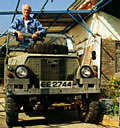 Keith Addison Keith Addison
Curriculum Vitae
Tai Long Wan
Tales from a vanishing village
Introduction
Tea money
Back to basics
Forbidden fruit
A place where nothing happens
No sugar
Treasure in a bowl of porridge
Hong Kong and Southeast Asia
Journalist follows his nose
Nutrient Starved Soils Lead To Nutrient Starved People
Cecil Rajendra: A Third World Poet and His Works
Leave the farmers alone
A timeless art
Health hazards dog progress in electronics sector
Mo man tai ('No problem')
"Write whatever you like" --a weekly column in Hong Kong Life magazine
Swag bag
Death of a Toyota
Zebra Crossing
On the wrong side of South Africa's racial divide
Kwela Jake
Sold into slavery
Mamelodi
Finding Tom Hark
Return of the Big Voice
Brother Jake
 Midori Hiraga Midori Hiraga
Curriculum Vitae
How I became a Third World journalist
Published stories
English
On the 50th anniversary of Hiroshima
Japanese use holiday to purge guilt over the past
Chinese migrant's battle to obtain degree
Filipino arts group shares message of hope and justice
Japanese
Hong Kong's handover 1997
"We are not products" Foreign domestic helpers in Hong Kong
Life as the only Japanese reporter on an English newspaper in Hong Kong
The team
The full expedition team will comprise 5-6 members. Handmade Projects fully intends that the project will be completed and the expedition will arrive in Cape Town having accomplished its mission. Thus nothing is indispensable – equipment and vehicles will be replaced if needed, and so will team members, including core members, should they be unable to continue for any reason.
All team members will fill multiple roles. Qualifications include some or all of the following: communications and media skills, education/teaching skills, languages, rural development/agricultural skills (especially small-scale, traditional), forestry, healthcare/first aid, practical skills, mechanical skills, and general usefulness.
Teaching mainly concerns the Journey to Forever schools projects; in the context of development work in Third World villages, learning is much more important than teaching if the outcome is to be a good one.
Back to top
|

![]()







 Keith Addison
Keith Addison Midori Hiraga
Midori Hiraga